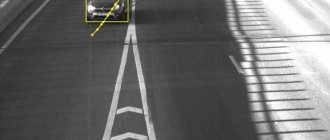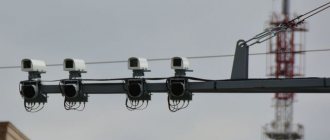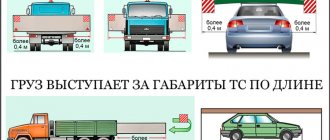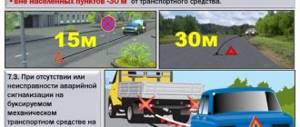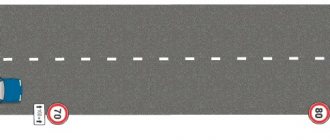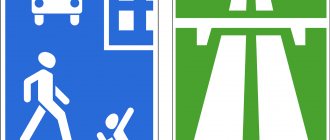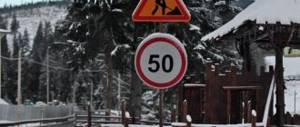Article 12.9 of the Code of Administrative Offenses of the Russian Federation (hereinafter referred to as the Code of Administrative Offenses of the Russian Federation) is devoted to the issues of punishment for exceeding the established speed limit. All the fines described in it can be divided into 3 large groups.
The first group includes penalties for a one-time violation of the speed limit, the second includes repeated violations, and the third includes violations that were recorded by automatic traffic cameras.
In the article we will describe in detail fines and other types of punishment for speeding as of 2021, and also present a table of the maximum permitted speed on different vehicles in the city and outside populated areas.
At the end of the article, we will touch upon the issue of ways to appeal fines for exceeding the speed limit if they were assigned by an inspector based on mobile radar data.
One-time speeding
The first table describes the responsibility for speeding, which was recorded by traffic police inspectors and committed for the first time. This means that either the excess was not previously recorded by this driver, or more than one year has passed since the last payment of the fine (or from the moment the license was issued, if deprived of it).
| Excess amount | Type of responsibility | Article of the Code of Administrative Offenses of the Russian Federation |
| Up to 20 km/h | — | — |
| From 21 to 40 km/h | Fine 500 rubles | Art. 12.9, paragraph 2 |
| From 41 to 60 km/h | Fine from 1000 to 1500 rubles | Art. 12.9, paragraph 3 |
| From 61 to 80 km/h | Fine from 2000 to 2500 rubles | Art. 12.9, paragraph 4 |
| More than 80 km/h | Fine 5,000 rubles or deprivation of rights for up to 6 months | Art. 12.9, paragraph 5 |
The rules have changed
Since 2021, the Russian Code of Administrative Offenses has introduced some innovations related to the amount of fines.
So, you have received a “chain letter” informing you of a punishment in the amount of 2,000 rubles. This means that you violated traffic rules.
Since January of the new year, such an amount will be imposed if the speed limit was exceeded or an incorrect stop was made. If you violate the rules for transporting dangerous goods, you will be fined the same amount.
Most often, car owners are punished for exceeding the speed limit on the roads, sometimes even slightly. The traffic police inspector draws up a report and issues a fine. The driver who committed the violation is issued a decree.
Violations are often recorded automatically using a camera.
Repeated speeding
The second table describes fines and other penalties for repeated speeding, that is, for speeding twice within one year. The year is counted from the date of payment of the previous fine. In this case, the punishment implies higher fines or deprivation of rights for up to 1 year.
| Repeated excess value | Type of responsibility | Article of the Code of Administrative Offenses of the Russian Federation |
| From 41 to 60 km/h | Fine from 2000 to 2500 rubles | Art. 12.9, paragraph 6 |
| From 61 to 80 km/h | Revocation of driver's license for 1 year | Art. 12.9, paragraph 7 |
| More than 80 km/h | Revocation of driver's license for 1 year | Art. 12.9, paragraph 7 |
Speed violation recorded by cameras
The fines that were assigned to drivers based on the readings of traffic cameras have an important feature - they are usually issued at the lowest possible threshold. For example, if a violation implies a fine of 1,000 to 1,500 rubles, then when it is recorded by cameras, a lower limit will be assigned - 1,000 rubles.
In addition, violations captured by cameras cannot result in deprivation of rights. Only the maximum fine for this type of violation will be issued. In case of repeated speeding, a fine of 5,000 rubles will be imposed.
| Exceedings recorded by traffic cameras | Type of responsibility |
| Up to 20 km/h | — |
| From 21 to 40 km/h | Fine 500 rubles |
| From 41 to 60 km/h | Fine 1000 rubles |
| From 61 to 80 km/h | Fine 2500 rubles |
| More than 80 km/h | Fine 5000 rubles |
| Repeated excess of 41 to 60 km/h | Fine 2000 rubles |
| Repeated excess of 61 to 80 km/h | Fine 5000 rubles |
| Repeated excess of 81 km/h or more | Fine 5000 rubles |
For speeding, both fines and deprivation of a driver's license are provided.
know about the permitted speed and penalties for speeding , and not just guess, but know for sure.
The speed limits themselves on Russian roads are written in detail in Section 10 of the Road Traffic Rules. If you have a driver's license, then you should know about speed limits (well, if you don't know yet, then look at the traffic rules).
Now about penalties for speeding.
Penalties for speeding are prescribed in Art. 12.9 of the Code of the Russian Federation on Administrative Offences:
1. Exceeding the established speed of a vehicle by more than 20, but not more than 40 kilometers per hour - an administrative fine of 500 rubles.
2. Exceeding the established speed of a vehicle by more than 40, but not more than 60 kilometers per hour - an administrative fine of 1000 to 1500 rubles. If you repeatedly exceed the speed from 41 to 60 km/h, you will be fined from 2000 to 2500 rubles.
3. Exceeding the established speed of a vehicle by more than 60, but not more than 80 kilometers per hour - an administrative fine of 2000 to 2500 rubles or deprivation of the right to drive vehicles for a period of 4 to 6 months. If you repeatedly exceed the speed from 61 to 80 km/h, you will be deprived of your license for 1 year (with automatic photo-video recording - a fine of 5,000 rubles).
4. Exceeding the established speed of a vehicle by more than 80 kilometers per hour - an administrative fine of 5,000 rubles or deprivation of the right to drive vehicles for a period of 6 months. If you repeatedly exceed the speed limit by more than 80 km/h, you will be deprived of your license for 1 year (with automatic photo-video recording - a fine of 5,000 rubles).
for exceeding the established speed of a vehicle by up to 20 km/h (inclusive) .
For clarity, here is a brief schematic information:
21 – 40 km/h => fine 500 rubles.
41 – 60 km/h => fine 1000 – 1500 rubles. (if such violation is repeated - a fine of 2000 - 2500 rubles.)
61 – 80 km/h => fine 2000 – 2500 rubles. (if such a violation is repeated - deprivation of rights for 1 year; for automatic photo-video recording, the fine is 5,000 rubles.)
81 km/h or more => fine 5,000 rubles. or deprivation for 6 months (if such a violation is repeated - deprivation of rights for 1 year; for automatic photo-video recording, the fine is 5,000 rubles).
A repeated violation is considered to be a violation committed within the period from the date of entry into force of the decision on punishment and until the expiration of 1 year from the date of execution of the punishment (payment of a fine or expiration of the period of deprivation of rights).
And a little about automatic detection of speeding.
If speeding is recorded by a camera in automatic mode , then a fine is imposed in the minimum prescribed amount. In this case, warnings and deprivation of a driver's license do not apply.
Conclusion! Follow the speed limit and save your money! After all, if you save money, you almost earn money. And most importantly, it’s safer!
Follow the speed limit and save your money! After all, if you save money, you almost earn money. And most importantly, it’s safer!
Comments
Dmitry 06/15/2016 15:02 Good day.
On May 10 of this year, the camera recorded a violation under Article 12.9, Part 2, speed 66 when the permitted speed was 40. Accordingly, the fine was 500 rubles. On May 30 of this year there was a similar violation, but the fine was already 2,000 rubles, although Article 12.9, Part 3 is considered again. Violation under Article 12.9, part 2. Is it correct? Reply | Reply with quote | Quote
Administrator 06/15/2016 18:32 Hello, a fine under Part 2 of Art. 12.9 is 500 rubles. If the second speeding was also no more than 40 km/h, then the fine should also be under Part 2 of Art. 12.9 Code of Administrative Offenses of the Russian Federation 500 rub. Fine 2000 rubles. maybe only - according to Part 4 of Art. 12.9 (excess by 61 - 80 km/h) - according to Part 6 of Art. 12.9 (repeated excess by 41 - 60 km/h). If you are given a fine in violation of these provisions, then if you appeal the decision, the fine should be reduced.
Reply | Reply with quote | Quote
Vyacheslav 01/24/2017 11:06 A fine of 2000 rubles arrived. for repeated violation under Part 6. Art. 12.9 (repeated excess by 41 - 60 km/h). The first violation was recorded on 06/01/2015, the second on 12/28/2016 was in . in the Ivanovo region, I live in the Nizhny Novgorod region. QUESTION. 1. Are there any statute of limitations between fine and fine? 2. To appeal, do you need to go to the traffic police of the Ivanovo region? Or by mail?
Reply | Reply with quote | Quote
Vladimir 07.11.2016 19:19 the camera recorded an excess speed of 20-40 km/h. They issued a fine. After 30 sec. another camera also recorded this excess. Once again they issued a fine of 500 rubles. And if you place the cameras 20m apart and you for 20 seconds. slowed down the speed. How many fines would one be entitled to issue?
Reply | Reply with quote | Quote
Vyacheslav 01/24/2017 11:07 A fine of 2000 rubles arrived. for repeated violation under Part 6. Art. 12.9 (repeated excess by 41 - 60 km/h). The first violation was recorded on 06/01/2015, the second on 12/28/2016 was in . in the Ivanovo region, I live in the Nizhny Novgorod region. QUESTION. 1. Are there any statute of limitations between fine and fine? 2. To appeal, do you need to go to the traffic police of the Ivanovo region? Or by mail?
Reply | Reply with quote | Quote
Vyacheslav 01/24/2017 11:10 2 times exceeded the speed limit by 45 km.
Reply | Reply with quote | Quote
Alexey 03/15/2017 08:29 The traffic cops caught me with a photo recorder, speeding by 71 km/h; before that there were speed violations, will there be a fine or imprisonment?
Reply | Reply with quote | Quote
Alexey 03/15/2017 08:31 wrote 12.9.ch4, but this is part 3? in the protocol and an increase of two km more they wrote the place 71,73
Reply | Reply with quote | Quote
Yakov 07/18/2017 13:17 The company received a fine for repeated excess, although for me this is the first time in my entire life, is it possible to protest and redo it like the first time?
Reply | Reply with quote | Quote
Kirill 09/13/2017 20:10 The traffic police officers said that I already have 7 fines in a year for exceeding 21 - 40 km/h, so I need to re-submit the verbal part of the traffic rules and my license will be confiscated. Is this correct?
Reply | Reply with quote | Quote
Nikolai 11/10/2017 11:01 The speed recorder recorded a speed of 67 km when the speed limit is up to 40 km, is there a fine for exceeding 7 km?
Reply | Reply with quote | Quote
Denis 07/31/2018 18:52 you exceed 27 km/h. Is there a fine for this???
Reply | Reply with quote | Quote
Alexey 06/07/2018 13:36 I quote Vyacheslav:
A fine of 2000 rubles came. for repeated violation under Part 6. Art. 12.9 (repeated excess by 41 - 60 km/h). The first violation was recorded on 06/01/2015, the second on 12/28/2016 was in . in the Ivanovo region, I live in the Nizhny Novgorod region. QUESTION. 1. Are there any statute of limitations between fine and fine? 2. To appeal, do you need to go to the traffic police of the Ivanovo region? Or by mail?
Reply Reply |
Reply with quote | Quote Magomed 06/13/2018 15:41 My car is registered to my brother, I exceeded the speed limit by 60 km but not more than 80, but the fine came 5,000 rubles for a similar violation, but this is the first such fine for me, but my brother had such a fine last year, but to another car
Reply | Reply with quote | Quote
Denis 07/31/2018 18:50 Why aren’t fines issued for half the price? not provided for all articles?
Reply | Reply with quote | Quote
Victoria 08/03/2018 09:50 Tell me, over the year I received about 6 fines for speeding 20-40 km/h, now I have received two more fines from July 25 for 250 rubles - it can be paid, and from July 27 for 500 rubles, it is written that payment is not possible. Everything is video recorded. What could this mean?
Reply | Reply with quote | Quote
Update list of comments
Add a comment
JComments
Maximum speed limits
There are generally accepted speed limits that apply throughout Russia. They depend on the type of vehicle (cars, trucks, motorcycles, buses) and the type of road (highway, road in and outside a populated area, residential area). Other factors also affect the maximum speed, including the presence of a trailer or towing, transportation of children, passengers or dangerous goods .
Below we provide a table that briefly and clearly describes all the speed limits for different roads as of 2021.
| Type of vehicle\Type of road | Highway | Road in a village | Road outside the populated area | Living sector |
| Cars and trucks with a maximum permissible weight of up to 3.5 tons | 110 km/h | 90 km/h | 60 km/h | 20 km/h |
| Trucks with a maximum permissible weight over 3.5 tons | 90 km/h | 70 km/h | 60 km/h | |
| Cars with trailers | 90 km/h | 70 km/h | 60 km/h | |
| Intercity and small buses | 90 km/h | 90 km/h | 60 km/h | |
| Other buses | 90 km/h | 70 km/h | 60 km/h | |
| Trucks when transporting children | 60 km/h | 60 km/h | 60 km/h | |
| Motorcycles | 90 km/h | 90 km/h | 60 km/h | |
| Vehicles when transporting children | 60 km/h | 60 km/h | 60 km/h | |
| Towing other vehicles | 50 km/h | 50 km/h | 50 km/h |
The maximum speed in cities and other populated areas, regardless of the type of transport, is 60 km/h. On highways outside populated areas it is allowed to travel at speeds of up to 110 km/h. However, if sign 5.1 (“Highway”) is installed on them, then some types of vehicles are allowed to accelerate to 130 km/h. If we are talking about the transportation of oversized, dangerous or heavy cargo, then the maximum permitted speed is established by the transport contract.
The speed limits indicated in the table can be adjusted by prohibiting or prescriptive road signs (minimum, maximum speed), as well as information sign 6.2 (“Recommended speed”). The requirements of road markings, including the maximum speed limit line and stop line, should also be taken into account.
Mobile, portable and stationary radars
Excessive speed can be recorded either by stationary radars built into photo and video cameras for recording traffic violations, or by radars that traffic police inspectors (portable and mobile) use every day in their work.
Portable radars are hand-held devices that can be used to measure the speed of vehicles passing on the road while standing on the roadway. Mobile radars are located in patrol cars or on special tripods, at the edge of the roadway.
When a violation is detected by mobile or portable radars on the spot, an administrative offense resolution or protocol is drawn up if the driver disagrees with the charge (or in case of a violation that implies deprivation of rights).
These documents are delivered personally to the driver or by mail (if he refused to accept them). If we are talking about violations recorded by stationary radars (traffic cameras), then the resolution is sent to the violator by registered mail within 3 days after its preparation.
What to write in a complaint - step-by-step instructions
So, appealing a fine from a camera is quite simple. We will give you point by point what to write in the complaint itself.
1. The first paragraph contains the details of the resolution:
- what decree (about an administrative offense) was issued to you when you were given a fine from a speed camera,
- when and by whom it was issued,
- his number,
- number of the traffic rules violation
- article of the Code of Administrative Offences, under which the driver was charged.
It is also important to indicate the date of receipt of the decision so that it is clear that the deadline for filing a complaint has not been missed.
You will also be interested in:
- How to appeal a fine for not allowing a pedestrian to pass? Form, sample and instructions
- How to appeal (challenge) a traffic police fine?
- Is it possible and how to appeal (challenge) a fine online through State Services?
2. The following is the essence of the case - a brief description of what happened.
3. Then you need to list the arguments refuting the facts on the basis of which the decision was made. For example, another driver was driving, or the car was sold at the time of the offense.
4. In conclusion, it is written what you are actually asking for. For example, cancel a resolution due to the absence of an offense.
5. Your complaint must be accompanied by written evidence confirming that you are right, which we will talk about a little later. Always include a copy of your copy of the decision with your complaint.
At the end of the complaint, copies of the documents that are attached to it are listed.
6. When finishing writing the complaint, below the list of documents we put a date and signature.
How to dispute?
If you were stopped by a traffic police inspector and notified that you were exceeding the maximum permitted speed on a given section of the road, then you can try to challenge this statement:
- Be sure to ask to see the radar readings. The inspector cannot refuse this. Another car can easily be recorded on the device, which is due to the technical features of modern radars;
- If it turns out that the speed of movement was recorded by a mobile radar through glass, then its readings cannot be used; glass significantly distorts the accuracy of the measurement;
- Check the radar error. The permissible error is indicated in the certificate, which the inspector must provide to you upon request. If the speeding was within the error limit, then punishment can be avoided;
- Demand to show the original certificate of state technical inspection of the device, which must be carried out every 2 years.
When studying a mobile radar and the documents that come with it, you should pay close attention to the presence of a seal on the case and external damage to the device. When studying the documents, find out whether the device can be used by hand, in what weather it is allowed to be used, and what interference may affect its operation (precipitation, temperature, humidity).
In the radar at the time of checking the speed of movement, if the inspector was stationary, the stationary mode should be set; if he was moving in a car, the patrol mode should be set. Pay attention to the direction in which it was working (headwind, downwind) and what the range of the radar was in stationary and heavy traffic conditions.
All discrepancies should be entered into the administrative violation protocol, which will help in the future to challenge the fine in the State Traffic Inspectorate or in court.
When can you challenge a speeding camera ticket?
As judicial practice shows, you can appeal a fine that was applied to the owner of a vehicle based on the results of photo and video recording in the following cases:
- the vehicle license plate recognition program incorrectly indicated the license plate number, which was recorded using photo and video means, and therefore the fine (“chain letter”) was received by the wrong owner of the vehicle;
- in the photograph attached to the administrative case materials, it is impossible to distinguish the license plate of the vehicle, or it is impossible to correctly read the combination of numbers of the license plate;
- the protocol indicates that the technical means recorded a vehicle speed higher than the vehicle can reach. For example, the protocol says that the car was moving at a speed of 150 km/h, while according to the manufacturer, the maximum possible speed is no more than 130 km/h;
- the speed limit violation was recorded on a section of the road that is not subject to the speed limit;
- the violation of traffic rules was not committed by the owner of the vehicle, but by another person who took possession of the car against the will of the owner. For example, when a vehicle is stolen;
- a traffic violation was recorded using a technical device that does not have a certificate of conformity. For example, a video camera was used to record the speed limit, whereas it was intended to record violations related to road markings;
- if the owner of a vehicle has received several notifications for the same administrative offense, this is a violation of the current administrative legislation, since according to Part 5 of Article 4.1 of the Code of Administrative Offenses of the Russian Federation, no one can be held accountable twice for the same offense.
Vehicle drivers are interested in the question of whether punishment for violating traffic rules is possible if an appropriate sign has not been installed on the section of the road where photo or video recording is being carried out, which warns the driver that traffic control is carried out using technical means.
On January 21, 2013, Resolution No. 20 of the Government of the Russian Federation was adopted, which introduced amendments to the Traffic Rules. Thus, road sign 8.23 was added, which is called “Photo and video recording”. Moreover, it can be installed either independently or with an additional plate 3.24.
If the plate is installed together with the sign, it means:
- in the coverage area indicated in the sign, the movement of vehicles is or can be recorded using photo and video cameras;
- the presence of sign 8.23 on the road section indicates that the fixation is carried out using stationary technical means.
If the movement of vehicles is recorded using mobile means of recording, for example, measuring the speed limit using a radar, then sign 8.23 is not installed on the road section.
If sign 3.24 is not installed along with sign 8.23, then this is not a basis for canceling the fine for violating the speed limit. This opinion was expressed by the prosecutor of the Korenevsky district of the Kursk region V. Voropaev.
Vehicle owners are interested in the question of applying penalties to them when the car has already been sold and is being driven by another person.
The simplified procedure for the sale of vehicles has led to the fact that the new owner, without having time to register the car in his name, commits traffic violations, which are recorded by photo and video devices. Accordingly, the fine comes to be paid to the old owner. What to do in such cases?
In accordance with the norms of current legislation, a fine is issued in the name of the person in whose name the car is officially registered according to the traffic police. Therefore, the old owner has to pay.
Therefore, there are two options for getting out of this situation:
- on the day of execution of the purchase and sale transaction, re-register the vehicle to the new owner;
- appeal the decision to impose administrative liability in court. The law allows 10 days for this from the date of receipt of the notification (“chain letter”).
Current administrative rules establish a presumption of innocence, which means that an alleged violator of administrative law cannot be found guilty of an administrative offense until his guilt is proven.
However, this principle has an exception. The note to Article 1.5 of the Code of Administrative Offenses of the Russian Federation states that in the case of photographic or video recording of an offense, the owner of the vehicle is considered guilty of the offense committed until he proves otherwise.
To prove his case, the driver of the vehicle can use:
- a recording from your DVR, which captures driving along a section of the road, the movement along which was recorded using stationary photo or video equipment;
- photographs taken or a video recording of the section of the road for driving along which a penalty for violating the speed limit was applied, indicating that there are no speed limit signs;
- testimony of witnesses that confirm the driver’s position that he did not commit any traffic violations.

